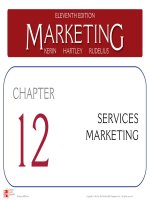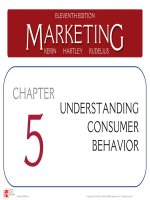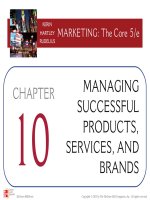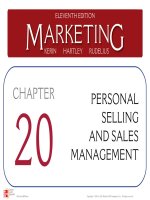Lecture Marketing: The core (5/e): Chapter 11 – Kerin, Hartley, Rudelius
Bạn đang xem bản rút gọn của tài liệu. Xem và tải ngay bản đầy đủ của tài liệu tại đây (3.51 MB, 47 trang )
McGrawHill/Irwin Copyright © 2013 by The McGrawHill Companies, Inc. All rights reserved.
LEARNING OBJECTIVES (LO)
AFTER READING CHAPTER 11, YOU SHOULD BE ABLE TO:
LO1
Describe the nature and importance of
pricing and the approaches used to
select an approximate price level.
LO2
Explain what a demand curve is and
the role of revenues in pricing
decisions.
LO3
Explain the role of costs in pricing
decisions and describe how various
combinations of price, fixed cost, and
unit variable cost affect a firm’s
breakeven point.
112
LEARNING OBJECTIVES (LO)
AFTER READING CHAPTER 11, YOU SHOULD BE ABLE TO:
LO4
LO5
Recognize the objectives a firm has in
setting prices and the constraints that
restrict the range of prices a firm can
charge.
Describe the steps taken in setting a
final price.
113
VIZIO, INC.—WHERE VISION
MEETS VALUE™ IN HDTV
114
LO1
NATURE AND IMPORTANCE OF PRICE
WHAT IS A PRICE?: THE PRICE EQUATION
Price
Barter
Price Equation
Veyron
vs.
EuroFighter
Drag
Race
Final Price = List Price – (Incentives + Allowances) + Extra Fees
115
FIGURE 11-1 The “price” a buyer pays can
take different names depending on what is
purchased
116
LO1
NATURE AND IMPORTANCE OF PRICE
PRICE AS AN INDICATOR OF VALUE
Value
Value =
$
Perceived Benefits
Price
=
$
Profit Equation
Profit = Total Revenue Š Total Costs
= (Unit Price
Quantity Sold) Š (Fixed Cost + Variable Cost)
117
FIGURE 11-2 Four approaches for selecting
an approximate price level
118
LO1
GENERAL PRICING APPROACHES
DEMAND-ORIENTED PRICING APPROACHES
Skimming
Pricing
Prestige
Pricing
Penetration
Pricing
Odd-Even $500.00
vs.
Pricing
$499.99
119
MARKETING MATTERS
LO1
Energizer’s Lesson in Price Perception—
Value Lies in the Eye of the Beholder
1110
LO1
GENERAL PRICING APPROACHES
DEMAND-ORIENTED PRICING APPROACHES
Target Pricing
Bundle Pricing
Yield Management Pricing
1111
LO1
GENERAL PRICING APPROACHES
COST-ORIENTED PRICING APPROACHES
Standard Markup
Pricing
• Cost
• Selling Price
1112
FIGURE 11-A Markups for a manufacturer,
wholesaler, and retailer on a home appliance
sold to consumers for $100
1113
LO1
GENERAL PRICING APPROACHES
COST-ORIENTED PRICING APPROACHES
Cost-Plus Pricing
• Percentage of Cost
• Fixed Fee
Experience Curve Pricing
1114
LO1
GENERAL PRICING APPROACHES
PROFIT-ORIENTED PRICING APPROACHES
Target Profit Pricing
Target Return-on-Sales Pricing
Target Return-on-Investment
(ROI) Pricing
1115
LO1
GENERAL PRICING APPROACHES
COMPETITION-ORIENTED PRICING APPROACHES
Customary Pricing
Above-, At- or Below-Market Pricing
Loss-Leader Pricing
1116
USING MARKETING DASHBOARDS
LO1
Are Red Bull Prices
Above, At, or Below the Market?
Price Premium (%)
Price Premium (%) =
Dollar Sales ($) Market Share for a Brand
–1
Unit Volume (#) Market Share for a Brand
1117
LO2
ESTIMATING DEMAND AND REVENUE
FUNDAMENTALS OF ESTIMATING DEMAND
Demand Curve
• Consumer Tastes
• Price and Availability
of Similar Products
• Consumer Income
• Demand Factors
1118
FIGURE 11-3 Demand curves for Newsweek
showing the effect on annual sales (quantity
demanded per year) by a change in price
caused by (A) a movement along and
(B) a shift of the demand curve
1119
FIGURE 11-3A Demand curve for Newsweek
showing the effect on annual sales by a
change in price caused by a movement
along the demand curve
1120
FIGURE 11-3B Demand curve for Newsweek
showing the effect on annual sales by a
change in price caused by a shift of the
demand curve
1121
LO2
ESTIMATE DEMAND AND REVENUE
FUNDAMENTALS OF ESTIMATING DEMAND
Price Elasticity of Demand
Price Elasticity of Demand (E) =
Percentage Change in Quantity Demanded
Percentage Change in Price
• Elastic Demand
• Inelastic Demand
• Product Substitutes
• Necessities
• Large Cash Outlays
1122
FIGURE 11-B Fundamental revenue concepts
Total Revenue
1123
FIGURE 11-4 Fundamental cost concepts
Total Cost (TC)
1124
LO3
DETERMINING COST, VOLUME,
AND PROFIT RELATIONSHIPS
BREAK-EVEN ANALYSIS AND BEP
Break-Even Analysis
Break-Even Point (BEP)
BEPQuantity
Fixed Cost
Unit Price Š Unit Variable Cost
FC
P Š UVC
1125









